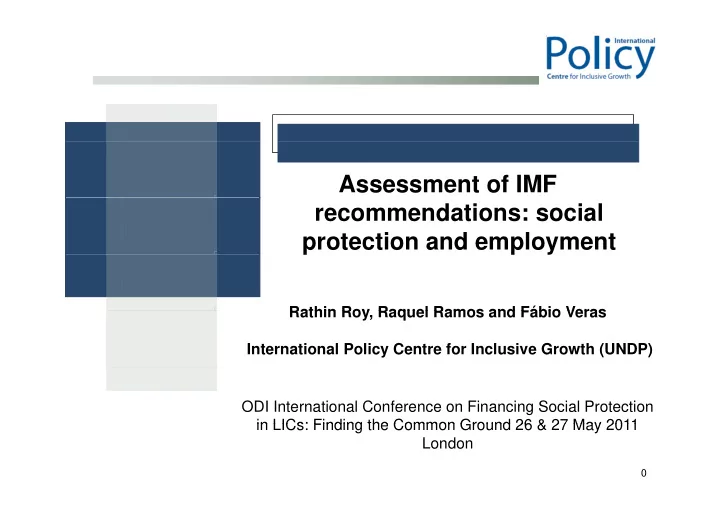

Assessment of IMF recommendations: social protection and employment p p y Rathin Roy Raquel Ramos and Fábio Veras Rathin Roy, Raquel Ramos and Fábio Veras International Policy Centre for Inclusive Growth (UNDP) ODI International Conference on Financing Social Protection in LICs: Finding the Common Ground 26 & 27 May 2011 in LICs: Finding the Common Ground 26 & 27 May 2011 London 0
Assessment of IMF recommendations… What is this research about? • An assessment of changes in policy recommendations of IMF after the crisis… as promised by its most prestigious figures. p y p g g Acknowledgement of double objective – inflation /stabilization as well as employment/output. Emphasis on automatic stabilizers – anti ‐ cyclical transfers specially E h i t ti t bili ti li l t f i ll to those who would consume more… 1
Assessment of IMF recommendations… Dimensions: • Authors will analyze how recommendations on inflation, exchange rate, fiscal consolidation and social g protection/employment are being dealt with after the crisis (on going research). • In this short presentation we will present some preliminary findings on social protection/employment on a sample of 25 findings on social protection/employment on a sample of 25 countries. • Methodology: review of IMF documents including Article IV Consultation reports. 2
Assessment of IMF recommendations… Sample of countries: • Income Classification: Low income: 5 Lower middle income: 13 Upper middle income: 7 • Regional Classification: Sub ‐ Saharan Africa: 8 Middle East and North Africa: 2 Latin America 4 Latin America: 4 Asia: 8 Europe: 3 Europe: 3 3
Assessment of IMF recommendations… Key questions: Do the recommendations differ depending on whether a country is low income or middle income? When referring to SP does IMF look at how to find fiscal space to expand SP/employment programmes? to expand SP/employment programmes? Is employment treated as a macroeconomic indicators or just as an indicator of whether or not labour market clears? 4
Assessment of IMF recommendations… Some preliminary findings: Out of 25 countries in the sample social policy and/or social protection and/or employment is just mentioned for 12 of th them. But when they are mentioned that is not necessarily because But when they are mentioned that is not necessarily because of their “per se” value. Sometimes they are just an indicator of how the economy is progressing, particular, employment (indicator of over/under heated economy) As for fiscal space, most recommendations rely on walking A f fi l d i l lki away from general subsidies towards better targeted transfers transfers. 5
Assessment of IMF recommendations… Some preliminary findings: For low income and low middle income countries almost nothing is said about social policy/social protection/employment For them most of the protection/employment. For them most of the recommendations are around public workers “rent ‐ seeking” behaviour driving overall wages/costs ups. Need to liberali e behaviour driving overall wages/costs ups. Need to liberalize labour market. In some cases for LICs, agricultural policies – improved seeds, fertilizers are seeing as the best anti ‐ poverty programme. Core social protection/social transfer policies programmes are only mentioned for emerging economies that are already on only mentioned for emerging economies that are already on the way of implementing them. 6
Assessment of IMF recommendations… Some preliminary findings: Recommendations with regard to Social protection programme in emerging economies look at the following issues: a) substitution of general subsidies, b) ways of i ) b tit ti f l b idi b) f improving targeting, c) need to increase internal consumption and fight poverty, d) improving human capital. and fight poverty d) improving human capital General impression that discourse on automatic stabilizers is a discourse for European and high middle income countries. Employment is not seen as key macroeconomic variable. l k bl Indicator for marker clearing policies only. 7
Assessment of IMF recommendations… Many Thanks (rathin.roy@ipc ‐ undp.org) 8
Recommend
More recommend